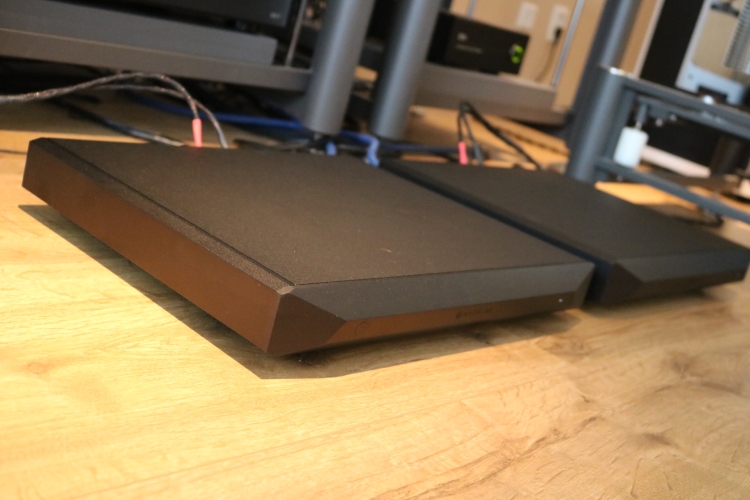
Review sample provided by Dimex
Retail price in the Netherlands: 3.995 euro per pair
A successor to the NuPrime Reference 20, the Evolution One contains the latest developments in technology and is the company’s current reference model. At almost 4000 euro per mono amp, they are not the incredible bargain that the ST-10 amp is but given my excellent experiences with that model, I was interested to find out how the company’s flagship models would compare.

Technology
The Evolution One contains some new developments such as a new input stage with a 1MΩ input impedance. According to the manufacturer, the high input impedance allows the pre-amplifier to see a much easier load and hence introduce less harmonic distortion and phase delay to the system. The latest NuPrime 700KHz high-speed switching Class-D modules are used which according to the manufacturer allow a greater resolution to be achieved. Contrary to the ST-10’s linear power supply, the Evolution Ones have a Switched Mode power supply on board and with a power rating of 240W into 8 ohms and 330W into 4 ohms, I’d be surprised if these amps ever run out of steam.
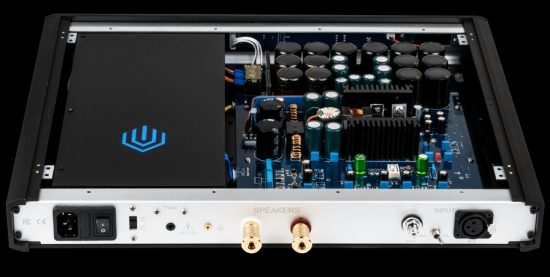
Class-D Sound
When the ICE power class-D amps hit the market in the shape of the Jeff Rowland model 201‘s I was initially amazed at the power and control available from such a diminutive component but it did not take long to realize that while certainly powerful, they were not ideal. They lacked resolution and tonal richness as well as soundstage depth but more importantly, I found the timbre to be unnatural. After ICE, came Pascal, again for me in Jeff Rowland guise and while the model 525 was better than ICE in terms of timbre and solidity I found this technique to result in an overly controlled sound and lacking treble fluidity. Naturally, there were many more implementations using ICE and Pascal modules that I have not used in a controlled environment but judging from what I heard at shows, it seemed that class D would never be it for me. Then I heard the NuPrime ST-10 using proprietary class-D circuitry and it changed everything. The ST-10 does not sound like a typical class-D amp at all. It has bass control and heft easily as good as the best Pascal amps I heard, a natural timbre even better than that of many class AB amps and while its transparency and resolution could be better and its treble lacks fluidity and air, the amp has such magnificent PRaT and makes for such a lively and engaging performance that you quickly forget about that.
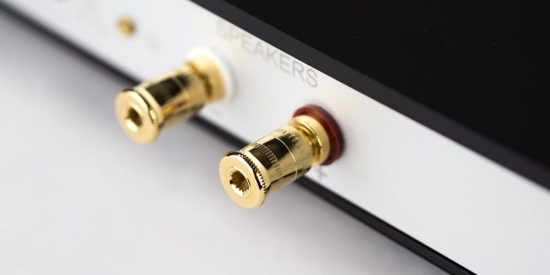
Listening
The Evolution Ones were used in several scenarios, both using my own systems as well as in two friends’ systems and a pattern soon emerged. Wherever they were used, they were like chameleons, always refrained from editorializing the sound. These amplifiers really are as neutral as they come.
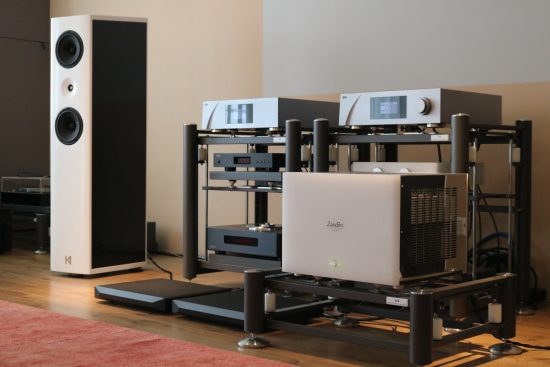
Kroma Audio Carmen
When the amps were delivered, I was just finishing off the Kroma Audio Carmen review so, naturally, I connected the Evolution Ones to them using the Melco N1ZH server, CH Precision C1 DAC and controller and Cardas Clear XLR cables. Speaker cables were the Jorma Design no.3. The Carmens are very efficient speakers and they certainly don’t need all of the Evolution Ones’ 240 watts but nevertheless, the sound was subtle and refined and with superb bass. Actually, the bass may actually be one of these amps’ strongest assets. While class D typically has taut and fast bass, even with difficult speakers, it often lacks weight and impact. The Evolution Ones, like the ST-10, however, has all the heft and body that you could wish for, combined with an amount of articulation and agility that most class A amps can only dream of. An aspect that ties firmly into this is the timbre or tonality. This is another aspect of the ST-10 that had me hooked, and it is fully retained in the Evolution Ones.
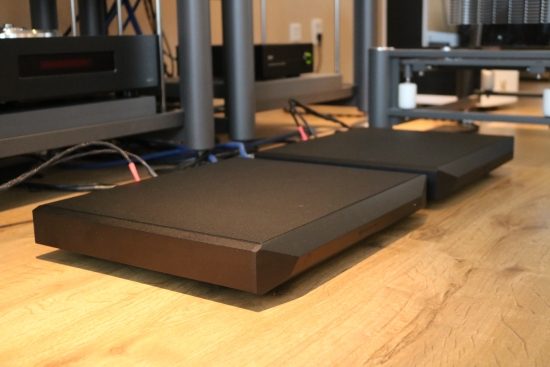
Wilson Watt/Puppy 8
While still in the confines of my listening rooms, I also used the amplifiers with the Wilson Watt/Puppy 8. The Wilsons are also quite efficient and behaved much like the Carmens, sounding entirely like themselves with excellent resolution and refined treble behavior and some of the best bass that I’ve heard the speakers produce. Speaking 0f the Wilsons’s treble behavior: while not harsh perse, they will definitely let you know when an upstream component has issues in the treble. The Evolution Ones absolutely do not.
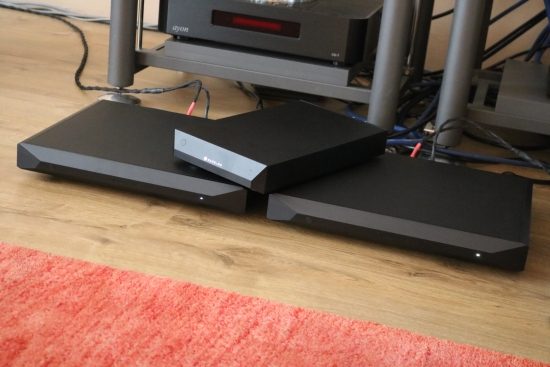
ST-10 on top of the Evolution Ones
Evolution
Speaking of the ST-10, the Evolution Ones have indeed evolved in various aspects. The Evolution Ones don’t quite reach the CH Precision A1’s insane level of ultimate resolution and refinement but they are miles more resolving than the ST-10 and actually have such excellent treble behavior that it becomes a non-issue. Indeed, these amps’ class-D engines simply are no longer identifiable as such. Soundstaging is another forte of these amps. Unlike many class-D designs that sound flat, the Evolution Ones portray instruments and vocals with their 3D bodies fully intact.
There’s also a new aspect to the Evolution One’s delivery that I find less attractive. Maybe it’s their insanely high input impedance, maybe it’s that they are more than lightning-fast or maybe it’s something else, but I found that their performance is highly dependent on recording quality. Great recordings sound really great and highly entertaining. These amps can sound truly lifelike when the circumstances are right and in these cases, I could not want for more. Mediocre recordings, however, will also sound that way. Don’t get me wrong – the amp does not exacerbate bad qualities, tonality is always good and they never become aggressive even with the lousiest of recordings but maybe they’ve become so very neutral and add so very little that some recordings start to lack that certain “lyrical” aspect and no longer incur an emotional involvement. My music collection contains a nice portion of sublime recordings but does not revolve around them. Rather, it probably consists mostly of “OK” quality recordings. Which is fine – I don’t need to revel in the best of the best all the time but I also don’t want a big part of my collection to sound uninvolving. In a way, this paves the way for the Evolution Ones’ raison d’être: they are true reference amps for those who want to hear everything that is on the recordings with no alterations whatsoever.
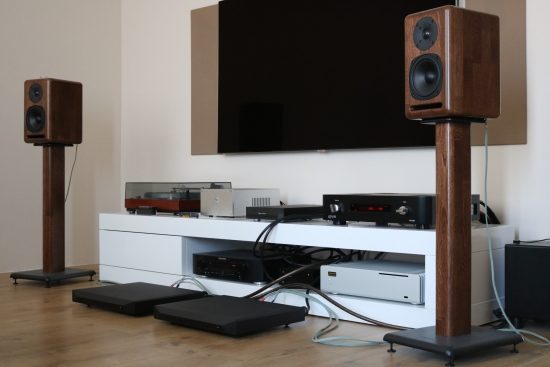
Xavian Perla Esclusiva
I also used the Evolution Ones for a few days in my secondary setup fed from an AudioAanZee Reference Flow music server with Euphony drive running Roon, via the Ayon Stealth DAC and preamp with the Xavian Perla Esclusiva and I made sure to give them enough warm-up time prior to critical listening. Actually, because they draw so very little power, it is a good idea to leave them switched on all the time. This will result in a freer delivery than when they’re just switched on from the cold.
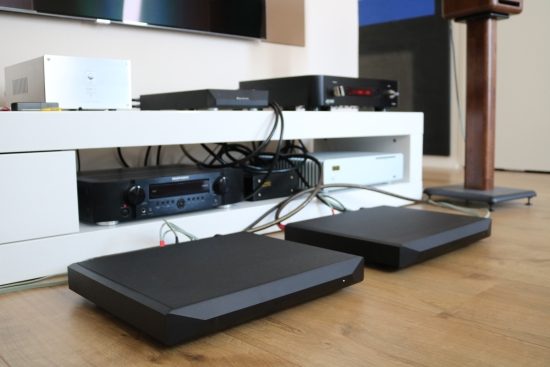
While the Evolution Ones drove the Xavians with the same self-effacing confidence and neutrality as with the Kromas and Wilsons, I began to feel that the amps were only idling along with the speakers used so far, not used to their full extent. They always relayed the recordings with super high precision but it was more cerebral than emotional. The ST-10, by comparison, was a lot less refined with the Xavians and certainly less transparent and well-balanced but it did sound more outgoing and more involving, throwing more of a party as it were, especially with lesser recordings. So, maybe the Evolution Ones liked to be challenged a little more?
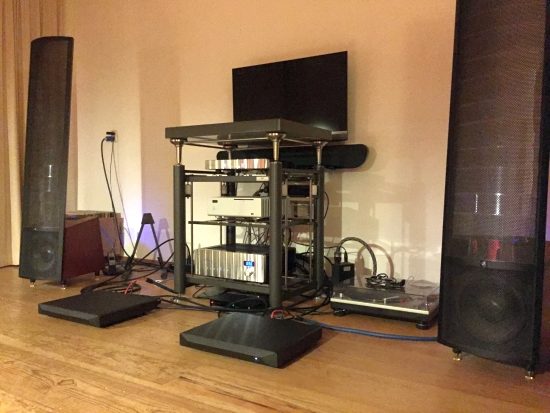
Martin Logan Spire
To find out, I first took the amps to audio buddy Niels to see how they would work in his system when combined with Martin Logan Spires. After firing them up I was reminded of how well the ST-10 worked with the Martin Logan ESL11A’s during their review. This time, too, the superbly natural NuPrime timbre worked wonders with Niels’ Logans, making acoustical instruments sound a lot more lifelike than with his usual Jeff Rowland Concentra II amplifier. Even if the Logans have active bass units, clearly they still benefit from being fed by an accurate source and the Evolution Ones’ superb bass was impressive here, too, the best we heard in this system, in fact. Also arguably even more noticeable with these speakers was the amps’ superiority over the ST-10 in terms of resolution and treble refinement.
Interestingly, while these speakers do not require much current at all, the amp-speaker match was perhaps the best so far even if it now became more evident that these amps won’t make a recording sound interesting unless this is in the recording itself. Martin Logans are highly resolving speakers but they also have the nice ability to always retain a certain continuity and this matched very well with the Evolution Ones. Other class-D amps that we tried in this system over the past years did not measure up but these NuPrimes, the system sounded great.
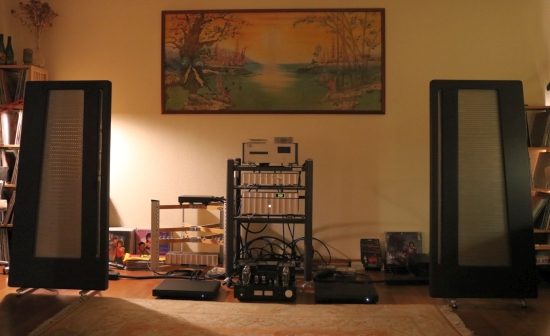
Apogee Duetta Signature
Finally, I took the amps to audio buddy JW to use with his Apogee Duetta Signatures. The speakers of this brand have become known as being extremely power-hungry and to some extent this is true but Duettas really are much easier to drive than Divas or Scintillas. Speaking of which, I presume that the Evolution Ones might have worked splendidly with the Divas! Fed from a Wadia 861 CD player via a Jeff Rowland Synergy IIi preamp with BPS and upgraded power supply and using Cardas Clear XLR cables, the Evolution Ones made the elderly Duetta Ladies sound like super-energetic teenagers. The speakers can sound a little relaxed with many amplifiers but not with these NuPrimes! Once again the bass was incredible, on par with the best I’ve heard these speakers produce, even JW was in awe about this. He’s always been an “overtone” person but due to us being friends for so long he’s picked up on my bass fetishism, just as I have inherited some of his ribbon obsession.
Timbre again was incredibly lifelike. This is not a certain coloration but rather the absence of any artifice. Even with the brutally honest Apogees, there was not a trace of synthesis to the Evolution Ones’ delivery and if the tick box of their treble performance was not yet ticked, it sure was now as neither of us could find fault with its treble delivery.
Regular readers will know of my experiments using various amplifiers with these speakers and that no class-D amp would sound right. The Evolution Ones are perhaps the best class-D pairing so far.
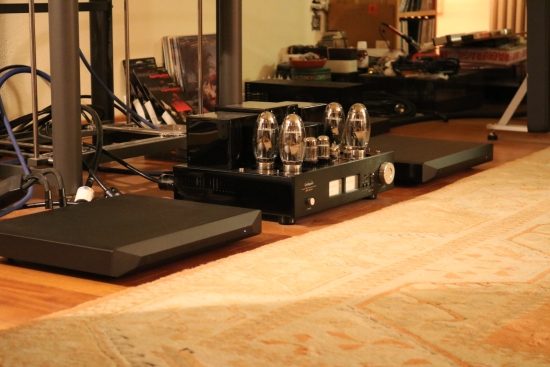
When there was enough fluidity in the recording the sound would also be very fluid with Logans and Apogees alike. Fourplay and Peter White, for example, sounded like the smooth, smooth bands that they are, undiminished. But when the music consisted more of staccato sounds then I’d start to notice a certain discontinuity between the transients, as if decays and subtle reverbs were made shorter than I’d like and that in turn can, for me, translate to a less emotional delivery.
The Wadia CD player is relatively dry itself and the Apogees are pretty ruthless themselves, meaning that the NuPrime amps’ more matter of fact presentation now became more noticeable. As mentioned before, this could be a caused by their super-high input impedance but it might also be the lack of smear-causing artifacts because the sound was as crisp and clear as I’ve ever heard it with these speakers, yet more timbrally convincing and truthful than I’ve heard them with any other amp.
Perspective
So far, aside from the NuPrime ST-10, the only class-D amps that I really liked are the MolaMola Kaluga amps which were on a visit at the same time as the NuPrime ST-10. The Kaluga’s worked splendidly with the Vivid Giya G3 mkII’s as well as the Apogees but even though the ST-10 could not match the Kaluga’s level of transparency, refinement, and fluidity, I still preferred the NuPrime because its timbre was so sonorous and acoustically convincing. Using customized N-Core modules, the Kaluga’s achieve a neutrality and total absence of amplifier sound that is, in hindsight, reminiscent of the NuPrime Evolution One’s behavior. Seeing as the Evolution Ones are not only more neutral and transparent than the ST-10 but also more highly resolving and refined while retaining that rich midrange texture and convincing tonality, they provide a very unique combination of strengths.
Conclusion
The Evolution Ones sound crisp and clear yet richly textured and timbrally natural, with excellent focus and a reach-out-and-grasp solidity to objects within the soundstage along with a level of lifelike purity and directness that is quite rare. The amps do not rose-tint of otherwise beautify the sound in any way which does make their performance highly dependent on the recording quality. These are reference amplifiers for those who wish to hear precisely what is in their recordings.
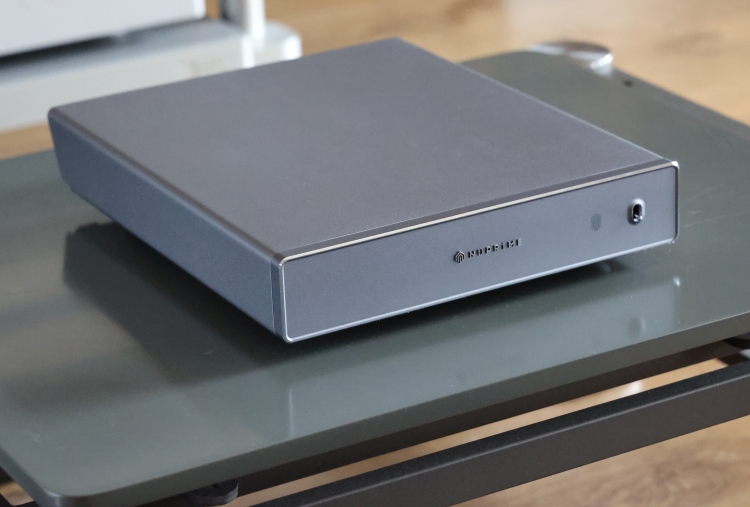
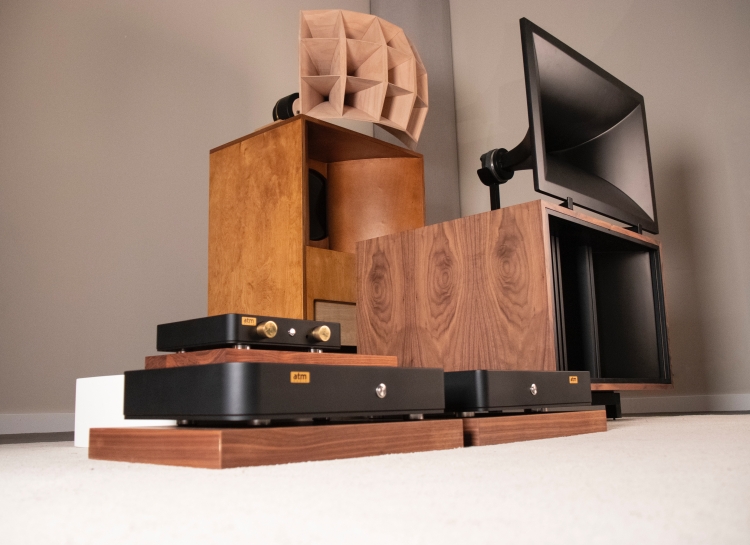
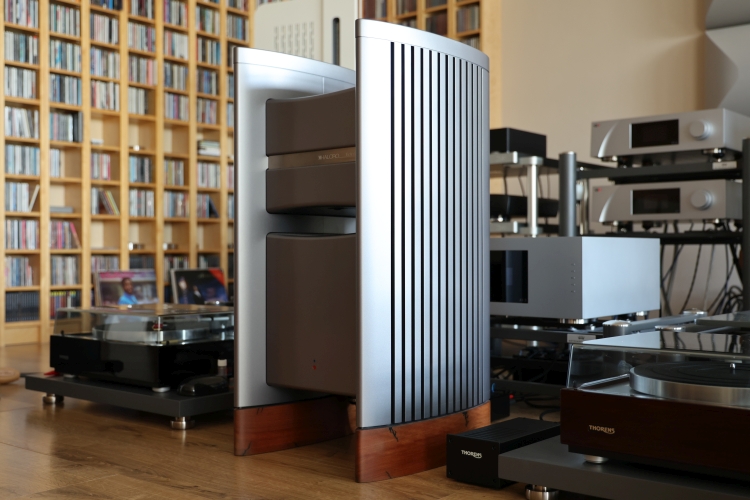
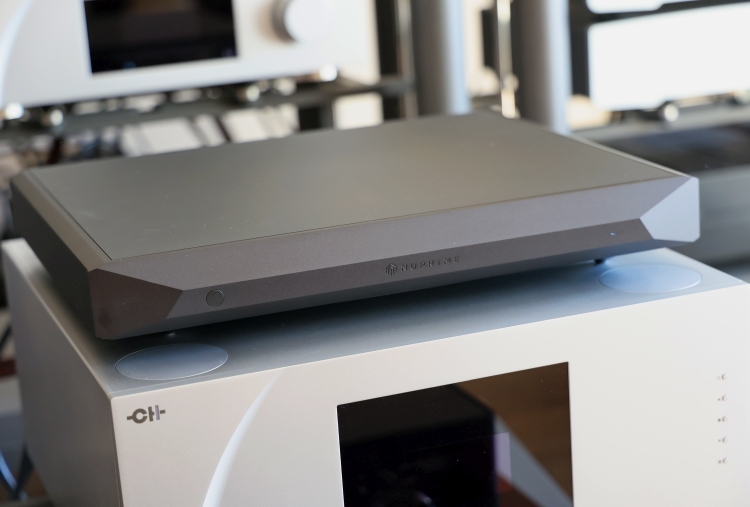
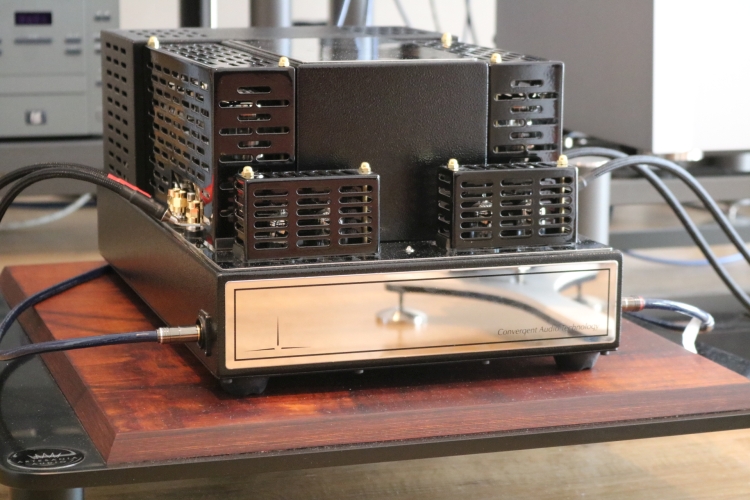
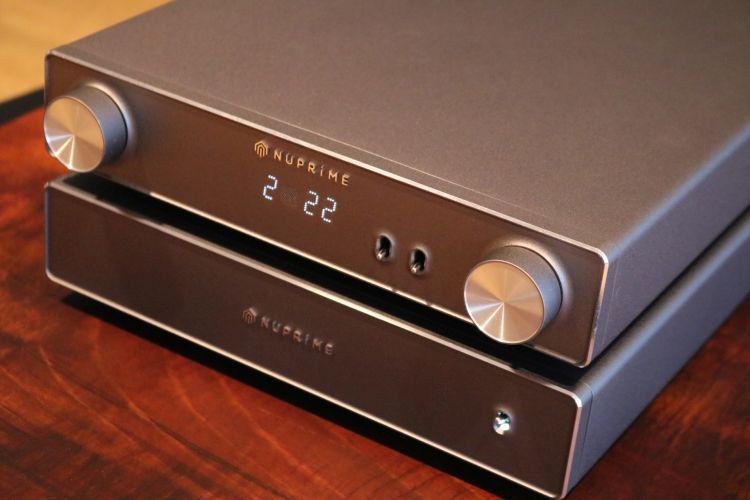
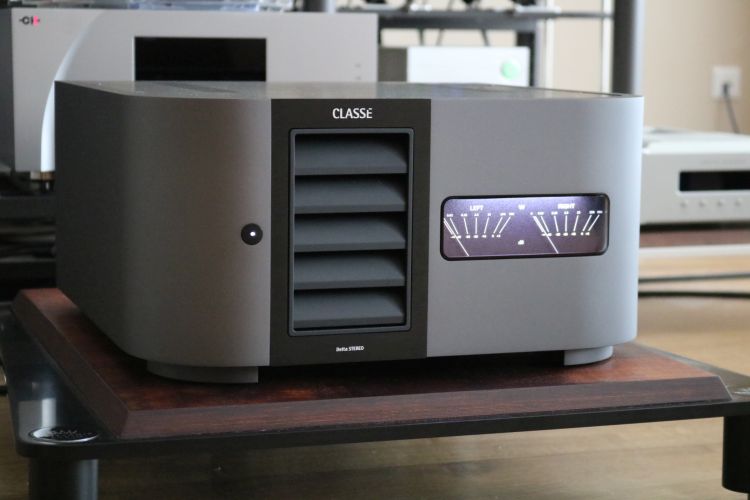
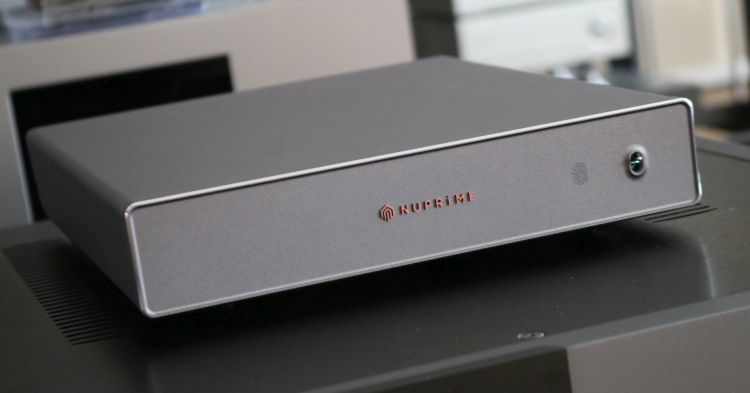
Thanks for this very informative review!
Class D amps are now much improved than a few years ago and this Evolution One seems to be in the league of top poweramps and having very good c/p ratio.
Do you agree?
One more question : Class D circuits often infuse pollution/noise into the home powerline and affect the other components adversely.
Do you notice such a pitfall on Evolution One mono poweramps?
Will putting them on a separate powerline in your house further improve the overall performance of your audio system?
Or is using some power conditioners/filters on them beneficial?
Many thanks again!
CK
Indeed this can happen, as I found with the Devialet 120 and 200 where the powered up 200 made the 120 sound noticeably less good. With the Evolution Ones idling while using the rest of the system I did not notice such a thing, nor with the Rowland class-D-based amps. That said, further improvements might still be had by using dedicated power lines. In general, I don’t like the results when using power conditioners but as I haven’t tried it with these amps, I can’t really say anything about this.
Hi Christian. How would you compare the Kalunga versus Evolution One irrespective of price. I often read your sight and we seem to have similar values around sound requirements. I currently use Martin Logan CLXs,. Waida and Ayre in the past.
They are almost opposites. Taking Wadia and Ayre as examples, the NuPrime EVO One is more like classic Wadia while the MolaMola Kalugas are more like Ayre. The Kalugas sound light-footed, open, airy, and transparent. They are really quite neutral if a little lean and gray and a little synthetic in timbre. The NuPrime EVO Ones are robust, full-blooded, earthy, impactful, dynamic, less spritely than the Kalugas and slightly dark, but very realistic in timbre. Personal preferences aside, I think most Martin Logan owners will find the combination with NuPrime most pleasing, unless they are looking for maximum openness.
Great insight thanks. Last question from my side looking at Jeff Rowland 535/525 versus Evo 1 would you still go for Evo 1 with Esls?
PS: Sorry for spelling error on prior post , was typing on the go.
Rowland 525 and 535 contain Pascal amplification modules. I’ve never been a big fan of these Rowland models but they do sound more robust and arguably texturally more realistic than the earlier ICEPower variants. In that respect, they are closer to the Evo One than the Kalugas. But so far, even when assessing other brands that use the Pascal modules, I have always found them to lack refinement, air, and, fluidity, and flow. ICEPower has a more synthetic timbre and is not as ballsy or impactful as I like but it is closer to the Kalugas in terms of these qualities (refinement, air, and fluidity). Then again, if you are looking to maximize these qualities and want the most transparent, most highly resolving, and most neutral variant, then I would go for the Kalugas in terms of overall performance. Or the “new” integrated Kula that is even more nuanced and refined, albeit at the cost of reduced impact and expression. In the end, it is a matter of taste. Do you want a sonorous, ballsy, impactful, and deeply saturated sound, or do you want maximum transparency? The advice would hinge on the answer to that question. Another amp to consider is the AMG-STA. Its sonic presentation (not necessarily its ultimate level of quality) is in-between the Evo One and the Molas and thus it provides a cost-effective manner to try and find out where your preference lies.
Hi Christian, Have you listened to the Anthem M1 and how do you compare to Evolution 1 ? Thanks
As a matter of fact I did! I had it over on loan from a friend and never made a review. I expected a lot from the M1 but it sounded rather flat, gray, and lifeless. It was controlled and stable, but then, basically every other Class-D amp is. Compared to many other amps, it lacked vigor, expression, and slam. Basically, it was a little dull and uninteresting. Quite the contrary of the later Anthem STR which sounds incredibly ballsy, espressive, and lively. Ultimately, I’m not sure if the M1 should be considered a hifi/highend amp or if it is more aimed at the PA world, where it would no doubt function well. In any case, NuPrime Evo One and Anthem M1 are for the most part rather different.
Great I found exactly the same thoughts when I had it for some weeks. Never listed to E1 or E2 so therefore the questions. Thanks so much.
First of all, I apologize for the imperfect English … I write from Italy. Many congratulations for this very interesting review!! I carefully follow the new NuPrime products as I’ve been using the ST-10 amplifier (often mentioned in the review) for a few years, and I’m very satisfied with it. I haven’t yet had the opportunity to listen to the new Evolution One amplifier, I hope to do so soon … but in the meantime I would be very curious to know,
Christiaan…. Honestly, do you think that the Evolution One improvements in comparison to the ST -10 are such as to justify the price difference (about 5 X)? Thank you! Luca
Ah, the million dollar question. Well, value with high-end audio is very much a relative matter. At a certain level, improvements cost ever more money. At some stage, you’re paying top dollar for ever smaller increases in quality. In the case of the Evolution Ones, it is clear that they perform better in all the areas in which the ST-10 performed comparatively less well, including class D’s typical Achilles heel: treble refinement and resolution. But is this worth 5 times the money? Only you can answer that for yourself, I’m afraid. What complicates the matter is that the ST-10 is an amp that has an enthusiasm that is instantly engaging even if you also notice immediately that it is not perfect. The Evolution Ones are technically much more perfect, but they are so precise and transparent and so revealing of the source that they can at times be less fun. You see? A better technical performance does not necessarily equate a higher fun factor. Ultimately, system synergy remains the most important factor and it is up to you to decide which aspect of music replay to place emphasis on.
Dear Christiaan,
Agree!
Very well said.
I think Class D amps are coming of age, particularly that the new Gallium Nitride transistors are available now.
Would you please consider to take a ook of and review the following two new Class D amps?
(1) Merrill Audio Element 118 or 116 mono poweramps
https://merrillaudio.net/products/
(2) AGD Production Vivace GaNTube Monoblock Amplifiers
http://agdproduction.com/
I think they are new stars and worth a n audition.
Many thanks!
CK
Thank you very much for your answer! Your considerations are certainly right and shareable!! In fact, you have represented my approach when buying the NuPrime ST-10: at the time, I had the opportunity to listen it compared to Reference 20 and, although I had a higher availability of spending, I considered that the improvements of the latter compared to the ST-10 were not such as to justify the considerable difference in price… I should now do the same after listening to the new Evolution One. Therefore, well said Christiaan! Many thanks again… Luca
For sure being a Panel guy I always seek this. “Do you want a sonorous, ballsy, impactful, and deeply saturated sound” As I mentioned I bought the Merdian Ultra DAC and after 3 months sold it to go back to my 10 year old Wadia 27ix
I always try to provide a balanced view and am careful to not to be black and white. But in your case, it seems NuPrime ST-10 or Evo One will be the best choice.
Nicely presented review, but please try to get the amps off the floor.
It’s a misconception that all equipment sounds better when on a rack or stand of some sort. Sure, it looks nice when off the floor and often enough that sounds better as well but for some components, the floor is as good a place as any, as is the case with these amps, or Bryston and CH Precision amps, for that matter. For some reason, they are not nearly affected as much as some other components. Also, all stands do not sound alike. The Artesania racks actually add very little of their own and sound much more like floor placement than for example a Pagode or Spider rack. The Artesanias do add a lot of refinement and provide better soundstaging but, ultimately, it’s all about balance and knowing the influence of various materials on the sound of any given audio component and I am very well aware of this. In my case, the floor lends a full-bodied sonority to the presentation which was welcome with these amps. The detrimental effects are known but even when not taking these into account, the Evos did not perform less well on those particular parameters than other amps placed on the racks. So, as I often say: it’s relative.
Hi Christiaan, thank you for your reply. My experience is that dealing with micro vibrations is essential, as I’m sure you would agree. Some audio furniture designs may actually add to problems if not carefully design. If placing on the floor the minimum I would expect is to use some good roller ball footer such as those made by Ingress or Symposium. Better would be to use them in conjunction with an appropriate platform material.
Thanks for your interesting website.
Hi,
Very good reviews . You make more useful information for two good product : the Evo amp and the ST-10 .. Congratulations… Do you evaluate the ST10M monobloc and compare It to the St10 setreo amp ? Do the monobloc better in the treble aera ? Regards
Thanks, glad you found it useful! A review of the ST10M’s is not in the pipeline but extrapolating what I know of the ST-10 and what I have heard of the mono versions, I don’t think that resolution and fluidity are very different between the mono and stereo versions.
Hi I have a particular question : I have the chance to get Nuprime ST-10M and Audio-gd Master-3 at the same price.
Please can you tell me in your opinion the tonal differences beetwen these two power amp? Any consideration is appreciated.
Thank you sir
Hi Alex, You’re in luck as I had just assessed the ST10M’s in my system only days ago. In short: the Monos have the same balance and character but provide more transparency, better articulation and more refined treble. Between the NuPrimes and the AGD Master 3, it’s pretty much a matter of opposites. The NuPrimes are sonorous, full-bodied, quite physical and a little dark. At the price there is precious little to criticize except for the treble resolution and the overall refinement. Nevertheless, that doesn’t change that they are very musical and engaging amplifiers.
The AGD Master 3 (and M2H’s as well) are leaner and faster, more open and more transparent. They have nearly state of the art treble, refinement and resolution and are clearly more audiophile than the NuPrimes. However, that is often a two-edged sword. Personally, I like hearing EVERYTHING but some people prefer to have things covered up a little. The AGD’s only downside is that they can sound timbrally less convincing when used with very revealing cables and speakers of sufficient neutrality. But as I found, using a full-sounding cable such as the Vermouth Reference (or a Cardas Hexlink Golden 5C to a lesser effect and with losses in resolution and refinement) will easily offset this.
Wow, you are very helpful Christiaan, thanks a lot.
I listen to a lot of electronic music, as well as rock, blues and house so I am looking for a fast, transparent, detailed and articulated amp, but at the same time with a rich, full-bodied tone, the midrange should be focused, I don’t like lean, thin or too open/bright sound.
My speakers are Dynaudio Evoke 50s, are pretty neutral and revealing, I am very happy with them, but they need a lot of current and many watts to give their best sound even at low-medium volumes.
In some forums I’ve read that AGD power amps sound transparent, fast and refined but with a natural tone somewhere like tubes, but maybe I’ve misread it.
You’re telling me that’s not the case, right?
Just curious, is it true what Nuprime says on their site about ST10Ms? “The improved power delivery and reduced interference gives the instruments richer overtones and more natural decay…… In an ensemble, the tonality gains an extra notch of richness which makes the overall presentation more natural compared to the ST10”.
Thank you sir. greetings from italy.
Hi Alex, what you seem to want is a combination of many audiophile aspects which does not normally come in affordable products. At this price point, there are always stronger and less strong areas.
All AGD products that I heard are indeed transparent, fast and refined and also natural. They are not warm or smoothed or particularly forgiving. “Tube sound” assumes a certain harmonic richness and warmth, which the AGD products do not have. But in my book that is a good thing. I never like transistor products that mimick tubes as inevitably they introduce only the lesser aspects of tubes, not the actual benefits. The Master 10 preamp strikes me as super-neutral and extremely even-handed yet excitingly dynamic. The power amps are somewhat leaner and slightly tilted toward the upper frequency range. The NuPrimes basically have the inverse subjective frequency response.
I do not hear richer overtones with the ST10Ms than with the stereo ST10. If anything, they’re slightly cleaner, more neutral and with more even-handed bass. I do hear more natural decay. Mostly, though, the monos have more refinement and better treble. They also have slightly higher resolution but do not match the AGDs in these areas.
I understand, do you have ever heard the A1 power amp of Audio-GD?
Or the last Nuprime AMG STA power amp?
Thank you Chris
Alas, I have not.
HI Christiaan
Bumping late on this very interesting thread and comments. Greta review and very beautiful pics. I’d be interested in your opinion about changing stock fuse in general in components, then for say, SR black or orange – in this unit particularly ? Sounds like it would make a great upgrade, as it seems to be widely claimed for… Btw, looking into this amp for Sonus Faber electa amator II speakers – that seems a good match. Your feedback wll be greatly appreciated. Thanks for your input.
Hi Arnold, I prefer sticking with the stock fuses for their most direct and neutral sound. That said, upgrade fuses such as the SR do have a very large effect but it has to fit your system and taste. Please refer to my Aries Cerat review for impressions of the SR Orange fuses.
For me, the EVO One is too much on the controlled side. I prefer the ST-10 or the AMG-STA. Also note that I am on the verge of reviewing the new Evolution STA. It is said to combine STA and ST strengths. I’d recommend postponing decisions until after that review:-)
Hi Christian
Thanks for your feedback
Well, too late, i indulged in an ST10… Let’s see how it sounds on the sonus then we”ll see about the new überprime version for the next future… These foolish thungs keep us happy as boys with new toys !
Ah, well, not to worry, the ST-10 offers massive value for money:-)
Yes, indeed. The Sonus sing beautifully with it. Thanks to you and this very thorough review that probably led many music lovers to new heights
Spec Corp would be my suggestion out of the class D contenders.
Dear Mr Punter
I’m so excited to test the new Nuprime Evo 2 SE. Are you planning to do it?
Regards
Hi Bruno, this is currently not in the planning.